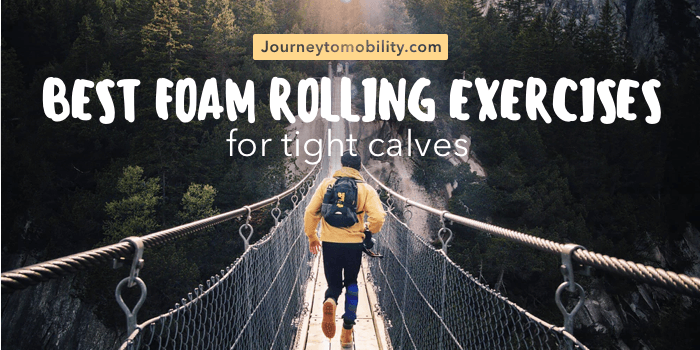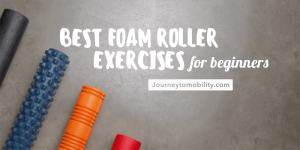The calf is made out of two muscle groups: the Gastrocnemius and the Soleus. The Achilles Tendon is a fibrous tissue that connects the calf muscles to the heel bone. Your calf muscles are likely stiff and you might not know it. Foam rolling helps to break down tightness and restore your range of motion.
Why do Calves get Tight?
Your calves may feel tight for different reasons. Most people have some level of tightness in their calves because of the amount of time we spend sitting. Over time, our calves adapt to being in a shortened position which leads to muscle tightness. Tight calves can also be a result of strenuous exercise (ex. running, swimming, sports). Overtime, tight calves cause discomfort and limits your ability to move.

Benefits for Foam Rolling Calf Muscles
- Improves circulation by promoting blood flow to your heart.
- Reduces scar tissue that adhere to different muscles and create tender areas.
- Reduces pain by kneading away scar tissues.
3 Simple Foam Rolling Exercises for Tight Calves Muscles
Foam rolling uses a technique called self-myofascial release to release tension stored in the muscles. Below are a few simple foam rolling exercises to help loosen up your calves.
1. Seated Calf Foam Rolling

Variation 1:
HOW TO: Position the foam roller on your soleus muscle (mid-lower section of your calves). Gently sit on the roller. Maintain a level of pressure that feels intense but manageable. If it gets too painful, simply release some of the pressure. Shift your weight gently from side to side to find trigger points. Once you’ve found tender areas, adjust the foam roller next to the area and hold while breathing calmly for 15-20 seconds. Move the foam roller up towards the knee pit and repeat the process. The key is to hold and relax.
NOTE: It’s normal to start off feeling a lot of discomfort with little to no pressure applied. After a few sessions, you will feel your calf muscles loosen up allowing you to apply more weight. Once you are able to sit comfortably on the roller, give the next variation a try!
Variation 2:
HOW TO: To intensify the pressure, use a wooden dowel or broom stick. Using a similar technique, work your way up and down the calves by applying pressure on either side of the stick with your hands. Hold while breathing calmly for 15-20 seconds.
NOTE: This variation gives you a lot more control and targets deeper layers of the fascia.
2. Soleus Muscle Foam Rolling

HOW TO: Place one calf on top of a foam roller using the arms and a bent leg as support. Gently and slowly roll back and forth. Go as slow as possible. If you find areas that are tender- adjust the foam roller next to the area and hold as you relax your breathing. Point and flex your foot work into the muscle fibres. You may also put the other leg on top if more pressure is needed.
The variation I like the best for this exercise is placing a peanut ball on top of a yoga block.
3. Inner/Outer Soleus Muscle Foam Rolling

HOW TO: To target the sides of your calves, tilt your calf to the side and repeat the same process as the exercises above.
NOTE: Again, you want to go slow for these exercises to access the deep fascia surrounding your muscles, bones, nerves and blood vessels. This is where you get the full benefits of foam rolling. I prefer the peanut and yoga block variation for this one as well.
How Long should I be Foam Rolling for?
Foam rolling works best in increments. You should only hold it on a tender area for 20-30 seconds.
Foam Rolling Routine for Calves
Long Roll-out Session (8 Minutes per Calf)
Divide your calves into four sections: the soleus, mid-calf region, the gastrocnemius and the inner/outer calves. Set a timer for two minutes a section. This gives us a total of eight minutes per calf.
Quick Roll-out Session (4 Minutes per Calf)
Divide your calves into two sections: the soleus to the gastrocnemius and inner/outer calves. Set a timer for two minutes each section for a total of four minutes per calf.
Conclusion
The benefits of foam rolling come back full circle to help your mobility, prevent injury and improve performance. Especially when you pair foam rolling with stretches that target the same muscle groups. I’ve written a post on some easy calf stretches you can use to pair with the foam rolling routine above. I have only started to incorporate foam rolling into my routine once I realized how much my body needed it and the importance of recovery.


